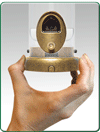Hello all,
It looks like another interesting weather weekend to hunker down and keep an eye on birdfeeders. All this wet weather does create some issues, however, that we would like to offer some prevention and maintenance tips for.
Mesh feeders like a shelled peanut or nyjer feeder are particularly troublesome in wet weather. As are feeders containing shelled sunflower. Such feeders really do benefit from a weather guard. The more rain you can keep off the feed the longer it will stay in good condition for the birds to consume and reduce your need to clean out clumped, rotting food. Yuck! Really wet feed is unpleasant to deal with.
Wire mesh peanut feeder with weather guard.
Aspects seed tube with weather guard and tray.
But even regular tube type feeders can collect moisture that settles to the bottom where a wet mess can turn into an unhealthy situation for your birds. Be a little more vigilante of feeder conditions at this time. Avoid refilling your feeder when there is a mass of wet clumped seed at the bottom. Weather guards of one kind or another can benefit tube feeders as well. And squirrel baffles serve well as weather guards. They are usually just larger versions of a weather guard.
Some feeders, like Aspects brand, have a very convenient push-button release base that allows you to clean out caked wet seed from the bottom in just seconds.
Aspects quick release base.
Clorox wipes are very handy for cleaning around feed ports. When the whole feeder isn’t ready for a cleaning just a quick wipe where the birds actually feed is very helpful to prevent unhealthy conditions.
If you have a platform feeder be very conservative about filling it in wet weather. Being totally exposed to the elements any seed out of the shell will deteriorate quickly. In the shell seeds are generally fine as long as the platform feeder has ample drainage, like a screened bottom. When I anticipate a period of rain I avoid adding any more seed to the platform feeder until the rain subsides. And before I refill it I use a putty knife, or old spatula, to quickly remove wet shell remnants.
If your tube type feeder has a tray the accumulation of shells and moisture can clog the drainage holes. Wiping the shell remnants out is easy enough using paper towels or a rag. Toothpicks are handy for cleaning out the drainage holes. And as always a good birdfeeder brush is essential to give tube feeders a deep cleaning. Warm soapy water is usually adequate but if you’ve let your feeder get really bad a mild solution of bleach and water and a few hours soaking might be necessary.
None of us really like cleaning our feeders but it really is a good and necessary thing to do if you enjoy this wonderful hobby. We hope some of these suggestions help and keep thinking sunny thoughts. The sun is bound to come back out sometime.












